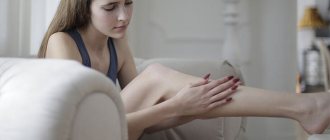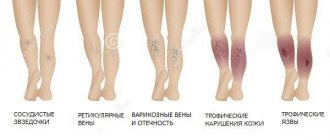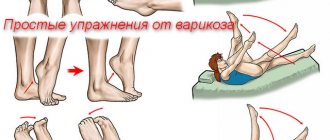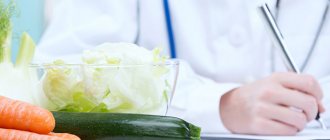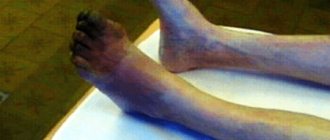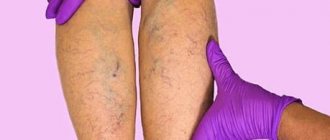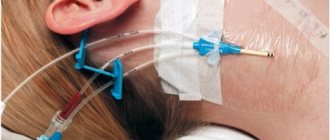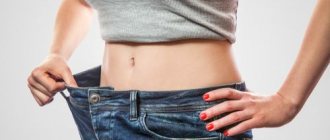How does a bath act on blood vessels?
The air temperature in the steam room of a classic Russian bath rises to 60-70°C, and humidity - up to 90%. These values are close to natural conditions and are well tolerated by a healthy body. Hot, humid air starts the process of redistributing blood supply to the arms and legs. The vessels dilate, the volume of circulating blood increases, and accordingly, the load on the veins and arteries increases. For healthy vessels, such a load does not pose a problem, but veins affected by varicose veins “delegate” it to the deep venous trunks. Frequent visits to the bathhouse with varicose veins provoke damage not only to the superficial, but also to the deep veins: their walls thicken and lose elasticity.
How to eat?
Before calculating nutritional norms, you should make sure that the body properly absorbs foods. Diseases of the stomach, intestines, and liver must be treated, since their condition is affected by the excess or deficiency of many important substances, and blood viscosity depends on the condition of the liver. Thick blood itself can be the cause of varicose veins, hence the dietary recommendations:
- Vitamins C, E and P are welcome;
- Blood thinning products are recommended (ginger, beets, tomatoes, cherries, dried fruits, etc.);
- Maintain a drinking regime, avoiding dehydration (30 ml per 1 kg of body weight per day for clean water and more for liquids), but do not bring yourself to edema;
- Increase in the diet the number of dishes with a high percentage of digestible dietary fiber (fiber), since they produce elastin, which is necessary for the strength of the walls of blood vessels;
- All foods that lead to weight gain or the formation of cholesterol plaques must be excluded from the diet, which is why it is recommended to more often eat seafood containing PUFAs (Omega-3), which promote the resorption of cholesterol, and digestible amino acids;
For the same reasons, you should avoid dishes with a high content of gelatin and reduce the consumption of spices such as salt (promotes swelling) and horseradish.
When are varicose veins and a steam room compatible?
Visiting a bathhouse for varicose veins of the legs is useful:
- at the initial stage of the disease, when there are no visible dilated veins, “nodules”, or swelling
- occasionally, without abuse
A steam room combined with a contrast shower/pool normalizes blood circulation, increases venous tone, this is an excellent preventive procedure. When visiting a bathhouse, those who have varicose veins should adhere to several simple but important rules:
- in front of the steam room - under a cool shower;
- the duration of stay in the steam room should be minimal;
- body position in the steam room - lying or standing, so that there are no unnecessary obstacles to blood flow;
- when using a broom, do not touch problem areas, massage with gentle movements in the direction from bottom to top;
- after the steam room - under a contrast shower.
Rules for visiting the steam room
There is no need to refuse to visit the steam room if you have varicose veins of the lower extremities. It is enough to follow the rules, thanks to which you can prevent damage caused to blood vessels by elevated temperatures.
The following recommendations will help turn the habit of steaming not into harm, but into benefit:
- for the first time you need to enter the steam room for no more than 2-3 minutes, this approach allows the vessels to adapt to the high temperature;
- You can use a broom, peeling and other procedures aimed at healing in those areas where varicose veins do not have a pronounced manifestation;
- one visit to the bathhouse means no more than 5 visits to the steam room; in case of more pronounced symptoms of varicose veins, they should be reduced to 3;
- When visiting the steam room, you need to pay attention to how your legs are positioned - they should be at the same level as your body.
High temperatures can cause discomfort in the legs where signs of varicose veins are most pronounced. To get rid of this manifestation, cover the affected areas with a damp cloth.
Bath for varicose veins in pregnant women
Is it possible for a pregnant woman with varicose veins to go to the bathhouse? Experts clearly give a negative answer. The fact is that during pregnancy, a woman’s body already experiences enormous stress, the circulatory system, liver, and lungs suffer the most. At this time, chronic, hereditary diseases, including varicose veins, worsen. The risk of complications is too great, so it is better to avoid going to the bathhouse or sauna for the entire prenatal period.
Complications after visiting the bathhouse
It should be remembered that you need to monitor your health yourself, and therefore, if you have varicose veins, you need to go to the bathhouse with extreme caution. Here are some of the symptoms to look out for when using a sauna for vein disease:
- pain in the leg muscles;
- cramps in the limbs (they can appear both during the day and at night);
- external manifestations - increased swelling with spider veins;
- heaviness in the legs;
- other associated complications.
Using sea salt in a bath for varicose veins
Too frequent visits to the steam room can lead to the progression of the disease, think about the consequences before going to the bathhouse for varicose veins. Among the most negative consequences, experts note:
- increasing the likelihood of the formation of trophic ulcers;
- an increase in the number of veins that have undergone deformation;
- stagnation of blood in the legs caused by a decrease in its fluidity;
- high risk of thrombosis against the background of resulting thrombophlebitis.
Visiting the sauna for varicose veins
Unlike a Russian bath, where the conditions are optimal and well tolerated by the body, in a sauna the air temperature warms up to 110°C with a humidity of no more than 20%. This ratio of temperature and humidity is suitable for the prevention of a number of diseases. However, in the case of varicose veins, it creates an excessive burden on weakened veins and can provoke the formation of blood clots. Therefore, visiting a sauna with varicose veins, regardless of the stage of development of the pathology, is not recommended. The same applies to an infrared sauna. IR radiation involves prolonged (about 1 hour) heating of the body, which is strictly contraindicated for varicose veins.
The effect of heat on affected veins
The steam room for varicose veins is generally a contraindication.
This is primarily due to the blood supply in the lower extremities. Thermal effects affect not only healthy, but also diseased capillaries, it expands them.
Due to the increase in BCC, each channel is forced to function in an emergency active mode. The affected area feels an incredibly large load at this moment.
The limited amount of residence time allows the veins to cope with the additional load. But over time, this will still lead to pathological changes.
Venous nodes will become noticeable on the lower leg, which, subsequently, due to a decrease in thermoregulation, expanded their walls and lost their elasticity.
If you have already noticed the prerequisites for the development of the disease, the effect of heat will not be a prevention, but rather a provoking factor.
Bath as a prevention of varicose veins
As a method of preventing varicose veins, the bath is irreplaceable. The conditions in the Russian steam room provide a gentle load on the cardiovascular system, without rapid heartbeat or shortness of breath. The traditional alternation of a hot steam room and a pool with cold water provides a sharp temperature contrast, which trains the cardiovascular system: the vessels expand and contract, their walls are strengthened and do not lose elasticity. Additionally, using a high-quality broom, you can perform a beneficial massage that will relieve muscle tension and improve blood circulation.
Cuperosis and bath
Cuperosis is a disease in which small vessels (venules, arterioles, capillaries) persistently dilate, causing their walls to become thinner and less elastic. Blood microcirculation is disrupted. The skin of some people reacts sensitively to minor temperature changes, washing, and touch, which is manifested by uniform redness of the frontal area, cheeks, neck and upper chest. In the future, the redness becomes permanent, caused by the expansion and fragility of blood vessels. Couperosis is manifested by spider veins and spider veins.
Bathing procedures aggravate the problem, so it is recommended to avoid such an event.
Varicose veins: recovery
Vein surgery is a serious intervention in the body; over the course of several months, a scar forms in the area of the operated vessels. This imposes certain restrictions on recovery
.
Immediately after the operation, the limbs are bandaged with elastic bandages or compression stockings are put on, which are selected in advance by the attending physician (degree of compression, type of medical underwear). The feet are placed on elevated bolsters and covered with ice. But lying down for a long time is not recommended! With minimally invasive interventions, you need to get up and walk within an hour or several hours. After phlebectomy (the so-called surgical removal of varicose veins) – one day later.
Main recommendations in the postoperative period
- Mandatory wearing of special jersey from 3 weeks to 2 months.
- After the intervention, especially after phlebectomy and mini-phlebectomy, drug treatment is prescribed during the recovery period. The course is aimed at eliminating pain, normalizing the tone of the veins and blood flow in them with the prevention of blood clots (anticoagulants), as well as relieving swelling (venotonics). Drugs are selected individually, taking into account the type of operation, tolerability and previous treatment, existing diseases. Course from 2 weeks to a month.
- Immediately after the operation and for the next 2 months, thermal procedures - baths, saunas, steam baths - are prohibited. If there are no special instructions from the doctor, then you can wash in the shower after 3 days or after removing the stitches (if they were applied), without harsh pressure and friction of the operated area.
- For 2 months you should not sunbathe or visit a solarium.
- It is important to maintain physical activity and take daily hour-long walks so as not to provoke deformation of the remaining veins. Active leg movements are shown, during which the muscles of the legs and thighs contract. Individual selection of a physical activity regime is also necessary. In order for recovery after varicose vein surgery
to be productive and positive, it is important to avoid prolonged lying and sitting, which leads to blood stagnation and the risk of complications, especially in overweight and elderly patients. - If varicose vein surgery is performed, recovery
is relatively quick. But during this period it is important to monitor the operation site. Any changes in this area (redness, itching, pain, swelling) require consultation with a doctor.
After about a month, it is quite possible to return to your previous lifestyle, but without lifting heavy objects, hypothermia or overheating of the legs, prolonged sitting or standing.
After surgery for varicose veins, recovery involves regular individual visits to the doctor. This depends on the volume and type of intervention, the patient’s age and existing concomitant pathologies.
How to choose knitwear for varicose veins?
Therapeutic knitwear with a compression effect is mandatory for use after surgery. Patients already before surgery have a question about how to choose knitwear for varicose veins
, what types of products to choose for the postoperative and subsequent rehabilitation period. Compression hosiery must be purchased in advance! Regardless of what operation will be performed, compression hosiery must, first of all, be of high quality and selected strictly according to size and other parameters. It is worth choosing knitwear from well-known European companies specializing in the manufacture of these medical products. The compression class is determined by the doctor.
After surgery on the veins, as a rule, knitwear of the second compression class is used, which applies therapeutic pressure to the deep veins. While products of the first compression class affect the superficial veins.
Features of the use of medical knitwear
- The doctor applies knitwear or elastic bandages immediately after surgery to reduce the risk of bleeding and hematoma formation. The product must be brought with you on the day of the operation.
- For the first few days, knitwear is worn constantly; in some cases, it is recommended not to take it off for the first 2-3 days, even at night.
- Socks, stockings, tights (the type of knitwear selected by the attending physician) should be put on in the morning, without getting out of bed, and worn throughout the day.
- It is recommended to wear these products for 1-2 months after surgery, which reduces the risk of relapse and progression of lesions in veins that have not yet been operated on.
Ask questions about how to choose knitwear for varicose veins
The doctor needs it before surgery. You cannot save or neglect wearing these products; their effect, although it seems invisible, is in reality very significant.
Recommendations from a phlebologist: diet, physiotherapy
From the first hours after surgery, it is necessary to adhere to certain recommendations of the phlebologist.
regarding diet and drinking regime. Thus, the use of dishes and products that help improve blood fluidity (“thinning”) is indicated. It is necessary to enrich the diet with vegetable oils with omega acids: olive, flaxseed, sea buckthorn oils, red and cherry berries, citrus and stone fruits. Shown are tomatoes and dishes with them, chocolate, nuts and seeds. It is equally important to add more foods containing magnesium to your diet, which prevents the formation of blood clots. Shown are porridges with whole grains, wholemeal bread, and muesli. It is important to consume enough fluids to prevent blood clotting, but at the same time not to increase swelling of the extremities. It is important to limit salt and sugar in your diet.
Also, on the recommendation of a phlebologist, sessions of physiotherapy, UHF, and to reduce swelling - lymphatic drainage massage and magnetic therapy can be prescribed. Additionally, the phlebologist will show you techniques for reducing swelling through self-massage, checking the correctness of all movements. Phlebologists at the TN Clinic will do everything possible to ensure that recovery after surgery occurs as quickly as possible.

